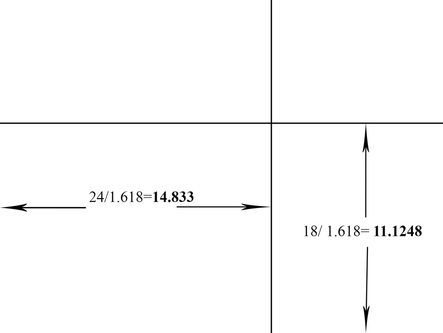Golden Ratio
What is the "Golden Ratio" and why does it apply to artists? The theory goes by many names; Golden Mean, Golden Rule of thirds, divine section, Golden number, etc. It is the theory of a perfect proportion division within a painting (or building, or a face, or anything really) that seems the most aesthetically pleasing. There is quite an elaborate formula equation for the ratio, but the only number you need to be concerned with is the end product of 1.618. The actual number is quite a bit longer, going into infinity, but for arts sake, lets round it to 1.618 shall we? We will use an 18 x 24 canvas as our demo size. If we use the Golden Ratio we will find the "most aesthetically pleasing" place to locate our focal point. Using the formula within the painting can also be a good idea to locate other objects. For now, lets concentrate on the focal point. Divide 24 by 1.618 to get 14.8331, then divide 18 by 1.618 to get 11.1248. I am not going to tell you to pinpoint the focal point EXACTLY at 14.8331 X 11.1248, but you will find that if you place the main object at or near this point you will have a balanced painting, at least aesthetically (and isn't that the point?).
What is the "Golden Ratio" and why does it apply to artists? The theory goes by many names; Golden Mean, Golden Rule of thirds, divine section, Golden number, etc. It is the theory of a perfect proportion division within a painting (or building, or a face, or anything really) that seems the most aesthetically pleasing. There is quite an elaborate formula equation for the ratio, but the only number you need to be concerned with is the end product of 1.618. The actual number is quite a bit longer, going into infinity, but for arts sake, lets round it to 1.618 shall we? We will use an 18 x 24 canvas as our demo size. If we use the Golden Ratio we will find the "most aesthetically pleasing" place to locate our focal point. Using the formula within the painting can also be a good idea to locate other objects. For now, lets concentrate on the focal point. Divide 24 by 1.618 to get 14.8331, then divide 18 by 1.618 to get 11.1248. I am not going to tell you to pinpoint the focal point EXACTLY at 14.8331 X 11.1248, but you will find that if you place the main object at or near this point you will have a balanced painting, at least aesthetically (and isn't that the point?).

Using this simple illustration, you will see the "best" location for your focal point, or main star of your painting. (This works for photographs too!!) Also be aware that this ratio creates FOUR points of perfection, although I haven't illustrated them. Mirror the image, or rotate 180 degrees, or turn it vertically and do the same, you will see four points of Golden Mean. Look throughout history at some of the most famous paintings and try to notice where the paintings that have stood the test of time use the Golden Ratio. It's there! I use this formula in my paintings as well. I am not going to tell you that I measure and place exactly at the point of Gold, but look and you will see I am usually close.
Notice also that our bodies, and face, are aesthetically pleasing using the same ratio! Many famous buildings' architecture used the Golden Ratio, such as the Parthenon built in ancient Greece. It's safe to say that the number has been around a while. Use this number for your paintings and see if they aren't strengthened by it's use!
Now, if the math formula has scared you, simply us the rule of thirds. Place the focal point 1/3 in from the edges and you will be close. Go on...try it!
Notice also that our bodies, and face, are aesthetically pleasing using the same ratio! Many famous buildings' architecture used the Golden Ratio, such as the Parthenon built in ancient Greece. It's safe to say that the number has been around a while. Use this number for your paintings and see if they aren't strengthened by it's use!
Now, if the math formula has scared you, simply us the rule of thirds. Place the focal point 1/3 in from the edges and you will be close. Go on...try it!